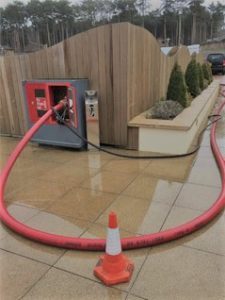 Dry Riser maintenance and testing needs to be carried out annually, with six monthly visual inspections in between. This is to comply with British Standard.
Dry Riser maintenance and testing needs to be carried out annually, with six monthly visual inspections in between. This is to comply with British Standard.
What is involved in Dry Riser maintenance and inspections?
The whole process of carrying out an inspection can involve a considerable amount of planning before even arriving on site! Think about if the location is in a busy town or city. There would be several things that would first need to be considered:
Is parking suspension required? Are there any exemptions from this? This will often involve seeking permission from local authorities and/or parking enforcement.
The Dry Riser testing equipment needs to be as close to the inlet as possible. This is to avoid causing obstruction or danger to pedestrians. Would you first need to cordon the area off?
Wet Testing should not take place if the temperature is below freezing as there would be a danger of pipes freezing and causing major damage.
There is also the risk of water being spilt and becoming a slip hazard to pedestrians.
What should happen when a professional arrives on site?
Once the testing equipment is on site, and the necessary surrounding areas have been cordoned off, a visual inspection of the system must be carried out initially.
The system is then charged with water and pressurized. It is held at a constant pressure for about 15 minutes to checked that the pressure can be maintained within the system.
Following testing completion, the system pipework is drained, outlet valves are closed and secured, and the inlet cabinet is closed and securely locked.
